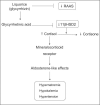Pseudohyperaldosteronism, liquorice, and hypertension - PubMed (original) (raw)
Case Reports
Pseudohyperaldosteronism, liquorice, and hypertension
Bruno Sontia et al. J Clin Hypertens (Greenwich). 2008 Feb.
Abstract
Consumption of large quantities of liquorice can cause hypokalemia and hypertension. These effects are associated with increased cortisol-mediated activation of renal mineralocorticoid receptors and hypoaldosteronism. The authors describe a patient with long-standing hypokalemia and uncontrolled hypertension related to excessive ingestion of liquorice. The case highlights the importance of obtaining a detailed dietary history, especially considering the increasing use of liquorice-containing foods, teas, and herbal products. The authors also discuss secondary causes of hypertension, focusing on pseudohyperaldosteronism.
Figures
Figure
Schematic demonstrating mechanisms whereby liquorice induces hypertension. Liquorice contains glycyrrhizin, which is converted to glycyrrhetinic acid in the bowel. Glycyrrhetinic acid inhibits activation of 11β‐hydroxysteroid dehydrogenase 2 (11β‐HSD2), an enzyme that converts active cortisol to inactive cortisone. 11β‐HSD2 is expressed in the renal cortex and the salivary glands. Decreased activation of 11β‐HSD2 results in elevated cortisol levels and increased binding to renal mineralocorticoid receptors. Mineralocorticoid receptor activation leads to Na+ reabsorption and renal K+ loss and consequent hypernatremia and hypokalemia. This is associated with elevated blood pressure. Liquorice (glycyrrhizin) may also inhibit the renin‐angiotensin‐aldosterone system (RAAS) by reducing renin secretion. ↑ indicates increase effect; ↓, decrease effect.
Similar articles
- Liquorice Toxicity: A Comprehensive Narrative Review.
Ceccuzzi G, Rapino A, Perna B, Costanzini A, Farinelli A, Fiorica I, Marziani B, Cianci A, Rossin F, Cesaro AE, Spampinato MD, De Giorgio R, Guarino M. Ceccuzzi G, et al. Nutrients. 2023 Sep 5;15(18):3866. doi: 10.3390/nu15183866. Nutrients. 2023. PMID: 37764649 Free PMC article. Review. - Lethal liquorice lollies (liquorice abuse causing pseudohyperaldosteronism).
Flores-Robles BJ, Sandoval AR, Dardon JD, Blas CA. Flores-Robles BJ, et al. BMJ Case Rep. 2013 Sep 19;2013:bcr2013201007. doi: 10.1136/bcr-2013-201007. BMJ Case Rep. 2013. PMID: 24051150 Free PMC article. - Licorice-induced hypertension: a case of pseudohyperaldosteronism due to jelly bean ingestion.
Foster CA, Church KS, Poddar M, Van Uum SH, Spaic T. Foster CA, et al. Postgrad Med. 2017 Apr;129(3):329-331. doi: 10.1080/00325481.2017.1291062. Epub 2017 Feb 15. Postgrad Med. 2017. PMID: 28276791 - Potassium chloride mixture may maintain hypokalaemia and hypertension.
Mandoe MJ, Borg R, Hansen D. Mandoe MJ, et al. BMJ Case Rep. 2018 Dec 14;11(1):e223732. doi: 10.1136/bcr-2017-223732. BMJ Case Rep. 2018. PMID: 30567256 Free PMC article. - Liquorice and its health implications.
Olukoga A, Donaldson D. Olukoga A, et al. J R Soc Promot Health. 2000 Jun;120(2):83-9. doi: 10.1177/146642400012000203. J R Soc Promot Health. 2000. PMID: 10944880 Review.
Cited by
- Licorice Toxicity Presenting As Refractory Hypokalemia and Hypertension in an Elderly Patient.
Albahlawan R, Alafifi M, Ambrose Fistus V. Albahlawan R, et al. Cureus. 2024 Nov 4;16(11):e72975. doi: 10.7759/cureus.72975. eCollection 2024 Nov. Cureus. 2024. PMID: 39498427 Free PMC article. - Safety classification of herbal medicine use among hypertensive patients: a systematic review and meta-analysis.
Choi D, Im HB, Choi SJ, Han D. Choi D, et al. Front Pharmacol. 2024 May 31;15:1321523. doi: 10.3389/fphar.2024.1321523. eCollection 2024. Front Pharmacol. 2024. PMID: 38881876 Free PMC article. - Primary hyperoxaluria: a case series.
Rather JI, Rasheed R, Wani MM, Bhat MA, Wani IA. Rather JI, et al. J Med Case Rep. 2023 Oct 7;17(1):421. doi: 10.1186/s13256-023-04129-z. J Med Case Rep. 2023. PMID: 37803380 Free PMC article. - Liquorice Toxicity: A Comprehensive Narrative Review.
Ceccuzzi G, Rapino A, Perna B, Costanzini A, Farinelli A, Fiorica I, Marziani B, Cianci A, Rossin F, Cesaro AE, Spampinato MD, De Giorgio R, Guarino M. Ceccuzzi G, et al. Nutrients. 2023 Sep 5;15(18):3866. doi: 10.3390/nu15183866. Nutrients. 2023. PMID: 37764649 Free PMC article. Review. - Close Call From a Sweet Twist: A Case of Licorice-Induced Torsades De Pointes.
Molina-Lopez V, Engel-Rodriguez A, Escabi-Mendoza J. Molina-Lopez V, et al. Cureus. 2023 Jan 24;15(1):e34126. doi: 10.7759/cureus.34126. eCollection 2023 Jan. Cureus. 2023. PMID: 36843745 Free PMC article.
References
- Farese RV Jr, Biglieri EG, Shackleton CH, et al. Licorice‐induced hypermineralocorticoidism. N Engl J Med. 1991;325(17):1223–1227. - PubMed
- Mumoli N, Cei M. Licorice‐induced hypokalemia. Int J Cardiol. 2007 Feb 21; [Epub ahead of print]. - PubMed
- Van Uum SH. Liquorice and hypertension. Neth J Med. 2005;63(4):119–120. - PubMed
- Palermo M, Quinkler M, Stewart PM. Apparent mineralocorticoid excess syndrome: an overview. Arq Bras Endocrinol Metabol. 2004;48(5):687–696. - PubMed
- Van Uum SH, Lenders JW, Hermus AR. Cortisol, 11beta‐hydroxysteroid dehydrogenases, and hypertension. Semin Vasc Med. 2004;4(2):121–128. - PubMed
Publication types
MeSH terms
Substances
LinkOut - more resources
Full Text Sources
Medical
